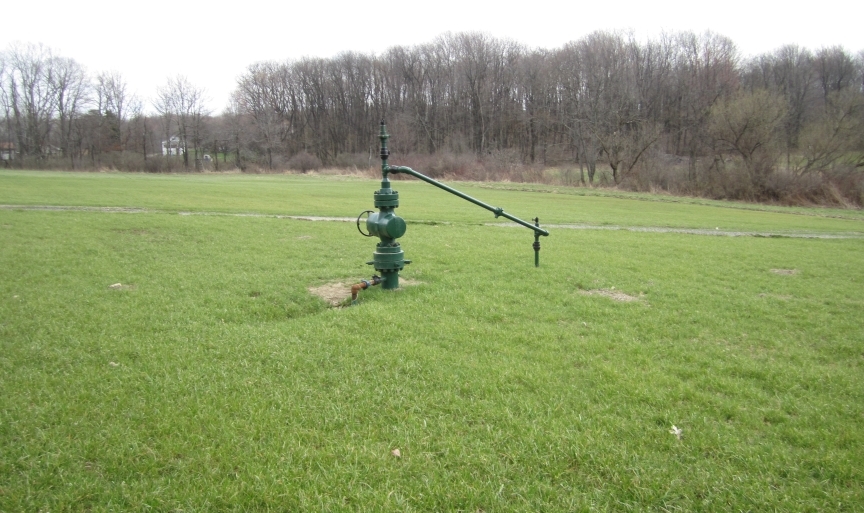Signs of pride and prosperity were evident all over Williamsport and the gorgeous northern Pennsylvania countryside around it. Friendly, happy people greeted us. New cars, trucks, hotels, and restaurants sparkled in a clean, bustling downtown. New roofs topped barns and houses, while late-model tractors worked the fields. Formerly dirt roads are now paved.
Men and women again have high-paying jobs, young people are coming back instead of moving away, their salaries are supporting other businesses and jobs, and many are taking college programs in oilfield technical and business specialties, Vince Matteo told me. As president and CEO of the Williamsport/Lycoming County Chamber of Commerce, he has witnessed the transformation.
“Ninety-eight percent of the change has been positive,” he says. Contributions to United Way are increasing each year, county infrastructure has improved enormously, and environmental impacts are minimal.
Productive, Green Technologies
Visits to several Anadarko Petroleum drilling and fracking sites explained why. Steadily improved fracking technology is now combined with computers, down-hole sensors, and microseismic instruments. Drilling equipment lets crews send a bit 6,000 feet down and 8,000 feet laterally into Marcellus Shale formations, and end up within three feet of their intended target.
The operations are conducted from atop a multilayered felt and impermeable plastic pad, surrounded by a berm, to keep unlikely spills from contaminating farm and forest land. Multiple wells are drilled from a single pad and “kicked out” horizontally in various directions.
A nearby impoundment is also lined with plastic to hold water for fracturing operations. Topsoil removed to prepare the pad and pond is stored nearby. As operations are finished, the land is reclaimed, topsoil is replaced, and local grasses, flowers, and shrubs are planted, to create meadows for deer and wild turkeys—or anything else the landowners prefer.
Once the work is completed, the area quietly and unobtrusively produces decades of energy—and revenue for farmers, wildlife organizations, hunting groups, and local, state, and federal treasuries.
Hydraulic fracturing takes place some 5,500 feet (almost four Empire State Buildings) below the water table. To prevent groundwater contamination, the pipe penetrating the first 700 feet is surrounded by layers of steel casing and specialized cement. During the drilling and fracturing process, even rainwater collected from the drill pad is saved and used. Some of the water used to fracture the shale is also recovered during gas production, and this “flowback” water itself is filtered, treated, and reused.
Water Consumption Overhyped
EPA says fracking consumes 70-140 billion gallons a year nationally, and the Texas Water Resources Board estimates Lone Star State oil and natural gas companies used 27 billion gallons of water for fracking statewide in 2011. However, Texas homeowners used 495 billion gallons for lawns and gardens, the TWRB found (18 times what fracking consumed), and household landscape irrigation nationwide consumes nearly 3 trillion gallons of water annually, according to EPA.
Even more revealing, according to the U.S. Department of Energy, fracking requires just 0.6 to 5.8 gallons of water per million Btu of energy produced. By comparison, “renewable” and “sustainable” corn-based ethanol requires 2,510 to 29,100 gallons per million Btu of usable energy, and biodiesel from soybeans consumes an astounding and unsustainable 14,000 to 75,000 gallons of water per million Btu.
Despite activist concerns, fracking has never contaminated water supplies. Fracturing fluids are 99.5% water and sand, and the 0.5% chemicals portion is increasingly basic, nontoxic household or kitchen stuff. Anadarko’s chemicals today are only “slickeners” (to help the sand get further into cracks created by the pressurized water) and “biocides” that prevent bacterial buildup in the well pipes. Every EPA, DOE and other study conducted to date has concluded fracking has never contaminated a single U.S. well.
Revitalized Economies
Hydraulic fracturing has created 1.7 million new direct and indirect jobs in the United States, with the total likely to rise to 3 million over the next seven years, HIS Global Insight reports. It has added $62 billion to federal and state treasuries, with that total expected to rise to $111 billion by 2020. By 2035, U.S. oil and natural gas operations could provide more than $5 trillion in cumulative capital expenditures to the economy, while generating more than $2.5 trillion in cumulative additional government revenues.
This game-changing technology has transformed global political equations and power structures. With the United States sitting atop centuries’ worth of now economically producible oil and natural gas, OPEC and Russia can no longer control prices.
Hollywood Hype
Why, then, do Hollywood and radical greens celebrate misleading films like Gasland and Promised Land, even after Phelim McAleer and Ann McElhinney’s documentary FrackNation completely demolished Gasland’s lies and distortions? Why do activists such as Food and Water Watch and the Sierra Club and ill-informed celebrities such as Yoko Ono continue to scream hysterical nonsense about the process?
Follow the money—and the ideology. FrackNation plausibly suggests Russia is putting big money into U.S. activist groups to stop us from threatening OPEC’s market share. Big Eco is big business, and big egos. It seeks ever-more power and ever-greater control over our lives. Fracking threatens all of that.
These shameful attitudes hurt people and the planet. We need to frack for a better, cleaner, happier world.
Paul Driessen ([email protected]) is senior policy advisor for the Committee for a Constructive Tomorrow and author of Eco-Imperialism: Green Power—Black Death. A shorter version of this article first appeared in Townhall.com. Reprinted with permission.





